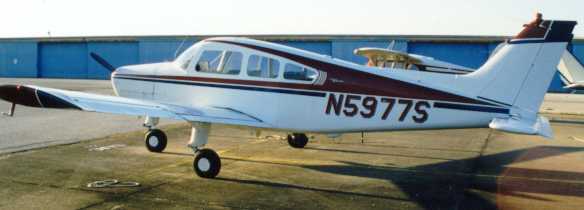
| BEECHCRAFT MUSKETEER |
|---|

| -- Flying the Mighty Mouse -- |
|---|
Preflight.
When I got checked out in this aircraft, I had only flown high
wing aircraft (with the exception of an intro flight in a Piper Tomahawk
about 5 years before I started to learn with the BAAC - the delay in learning
to fly due to lack of money!) Therefore preflighting was quite a
transition.
Low wings demand you get on all fours to sump the under-wing
drains. That was my only dislike about preflighting this aircraft (pictured).
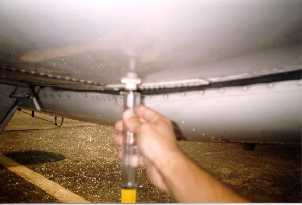 It's not much fun doing this if you get to the airport just after a rainstorm,
or if the ground is cold! When sumping this aircraft, you should be very
careful to check for water in the fuel. Our Musketeer, which is no exception,
has recessed fuel caps, and the O-rings are notorious for leaking (on ours,
on the left fuel tank). I drained three full cups of water out of the left
tank on a recent cross country flight - and the tanks were topped off when
I flew it last, so it wasn't condenstation! I've never seen water in our
172's tanks, which has the more conventional fuel filler caps.
It's not much fun doing this if you get to the airport just after a rainstorm,
or if the ground is cold! When sumping this aircraft, you should be very
careful to check for water in the fuel. Our Musketeer, which is no exception,
has recessed fuel caps, and the O-rings are notorious for leaking (on ours,
on the left fuel tank). I drained three full cups of water out of the left
tank on a recent cross country flight - and the tanks were topped off when
I flew it last, so it wasn't condenstation! I've never seen water in our
172's tanks, which has the more conventional fuel filler caps.
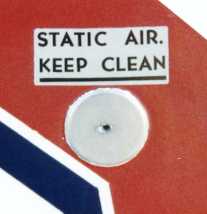 This aircraft has 2 static ports (pictured) to give accurate airspeed
readings when you slip the aircraft - most definitely a plus. It also adds
some redundancy (the Musketeer has 3 static air inlets - 2 outside, and a
pilot operated cabin static inlet).
This aircraft has 2 static ports (pictured) to give accurate airspeed
readings when you slip the aircraft - most definitely a plus. It also adds
some redundancy (the Musketeer has 3 static air inlets - 2 outside, and a
pilot operated cabin static inlet).
As the placard says, make sure it's clean as you preflight. Moving to the
rear of the aircraft, the biggest difference to the Cessnas I've flown is
that the aircraft has a stabilator, rather than a horizontal stabilizer plus
elevator.
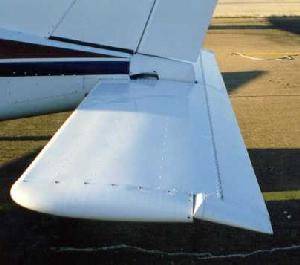 The stabilator includes an antiservo tab. The antiservo tab
is clearly visible here, on the trailing edge. Lifting the stabilator will
make the antiservo tab move up more than the stabilator. This gives the elevator
control some feel, and it also acts as a trim tab. This should be checked
for freedom and security, just like all other flying surfaces.
The stabilator includes an antiservo tab. The antiservo tab
is clearly visible here, on the trailing edge. Lifting the stabilator will
make the antiservo tab move up more than the stabilator. This gives the elevator
control some feel, and it also acts as a trim tab. This should be checked
for freedom and security, just like all other flying surfaces.
The Musketeer has a clean looking stabilator, which I find
aesthetically more pleasing than the same on Piper aircraft. What difference
in flight it makes, I don't know!
As the preflight continues, the nice thing about low wings becomes
apparent. Visually checking the fuel is easy, requires no climbing or sticking
your finger in the fuel tank. Just take the cap off, and you can clearly
see the fuel level. Beech provided tabs in the fuel tank - to the tab, the
tank has 15 gallons, to the slot it has 20, and full is has 29 usable. This
makes fuel decisions much easier as the fuel is easy to see. Not such an
issue at Houston Gulf at sea level, where I will fill up if more than an
hour is burned from full tanks, but at high density altitudes where weight
is critical, it would be nice to know just how much fuel to put in to be
safe. Tabs make this task easier. (Of course, there are caveats - park it
on a level surface or else you will get inaccurate readings).
Other items in the preflight are similar to what I've done with
every other aircraft I have flown.
Getting Started.
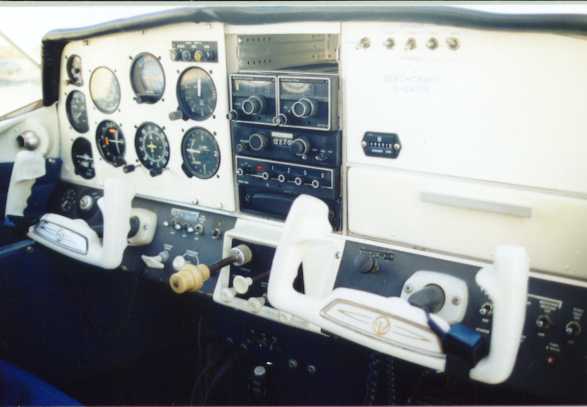
A nice feature of this aircraft is that it has an all-metal instrument panel. It also has a 'vernier' throttle which as well as being able to push and pull, you can turn for fine adjustments (notice the button on the throttle control in the picture - press this in to push or pull, or just rotate the knob for fine tuning). Funnily enough, the mixture control isn't vernier! In all other aircraft I've been in, the arrangement has been the other way round (except for the blissful time when our 172N had verniers for mixture and throttle). As you can tell, I like the vernier controls!
The aircraft has an injected engine. It took me a while to figure
out how to start it hot reliably! Injected engines are much more fussy about
the starting procedures, and one day I wasn't sure that I'd ever get it started.
The procedure I found that worked when the engine was hot was not the verbatim
POH way, but the 'flooded engine' procedure. You open the throttle full,
pull the mixture to lean then turn the key. As the mixture then gets to the
right level and the engine starts, you push the mixture in whilst simultaneously
pulling the throttle back to fast idle. You need 3 hands! If the engine is
just warm, then the normal hot start works just fine.
Run-up is done at 2,000 RPM, so you have to stand on the brakes
to stop it from creeping over the run-up pad. Other than that, the before-takeoff
procedure was not much different from a Cessna.
The only thing I don't like about the seating is that my knees
get cramped up at the bottom of the panel a little bit, but then again I'm
a bit lanky!
In flight.
With 200 horses, you feel a good acceleration on the takeoff
roll. When you break ground, all of a sudden your workload goes up! I've
heard from other Musketeer pilots that this aircraft needs to be flown all
the time, and it's certainly true. Constant small corrections are
needed to keep the wings level. Once you are levelled out, it's not so bad,
but the aircraft has a strong tendency to start rolling left or right (it's
not really predictable) if you just let go of the yoke long enough to refold
your chart. You really learn the art of trying to keep the wings level by
gentle rudder movements as you do this! A wing leveller would be really
nice.
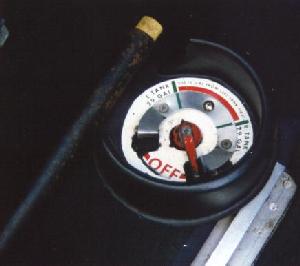 If you have been flying Cessnas, fuel management is a little
more complex in this aircraft. There is no "both" position, so you must regularly
switch tanks to keep a balanced fuel load, and more importantly, not accidentally
run a tank dry. The NTSB reports are scattered with incidents of pilots of
this type of aircraft making a forced fuel starvation landing when the still
have one fuel tank brimming with fuel!
To avoid the tank-switching trap, I keep my stopwatch rolling
and also put reminders on my flight log, and note down the switch time. That
way I know how much has been used in each tank when I arrive. Unlike Piper
fuel valves, this one is located on the floor between the left/right seat.
The fuel system also has a boost pump. This is used for cold starts and
emergencies (the engine may quit because the engine driven pump has failed,
so turning on the boost pump is an engine out procedure).
If you have been flying Cessnas, fuel management is a little
more complex in this aircraft. There is no "both" position, so you must regularly
switch tanks to keep a balanced fuel load, and more importantly, not accidentally
run a tank dry. The NTSB reports are scattered with incidents of pilots of
this type of aircraft making a forced fuel starvation landing when the still
have one fuel tank brimming with fuel!
To avoid the tank-switching trap, I keep my stopwatch rolling
and also put reminders on my flight log, and note down the switch time. That
way I know how much has been used in each tank when I arrive. Unlike Piper
fuel valves, this one is located on the floor between the left/right seat.
The fuel system also has a boost pump. This is used for cold starts and
emergencies (the engine may quit because the engine driven pump has failed,
so turning on the boost pump is an engine out procedure).
The aircraft is comfortable in cruise, and due to its weight
and high wing loading, it busts through turbulence, sparing you of the normal
sharp jolts that are all around at low altitudes during Texas summers. Control
feel is light, and the aircraft is easily trimmed for level flight. The low
wing doesn't get in the way very much for pilotage either, although high
wingers offer an undoubtedly superior pilotage platform. Manoevering is fairly
undemanding - the light elevator pressures make steep turns a breeze, but
a ham-fisted pilot could easily get into trouble! Power on and power off
stalls are docile. Just don't pull up too quickly in the recovery phase,
because due to the light control pressures, it's easy to stall it again.
Approach to the stall gives you lots of warning as the controls feel very
mushy, and plenty of buffet can be felt in the power on configuration.
Landing is where this aircraft shines. Approach at 81 MIAS (MPH
Indicated Airspeed) with full flaps, and the aircraft's weight busts through
the turbulence once again, which makes a stabilized approach easier to obtain.
The trailing link gear makes any reasonable landing a greaser, and crosswind
correction seems a lot less stressful than in the Cessna - I can almost think
the aircraft over the centerline.
There is one caveat, and I've been fortunate enough to never
experience this, but I've seen it happen to someone. The aircraft is nose
heavy, so if you flare high, the nosewheel will touch down first and you'll
start a major crowhopping bounce as the nose bounces up, then the mains bounce
and vice versa. Someone bent the prop in the club's other Musketeer (no longer
in the club) after such a landing. Therefore, careful attention to the flare
must be taken. Also a hard touchdown will start a major bounce (the pilot
I saw do this went around - he was still at flying speed and must have bounced
10 feet in the air).
| -- Conclusion -- |
|---|
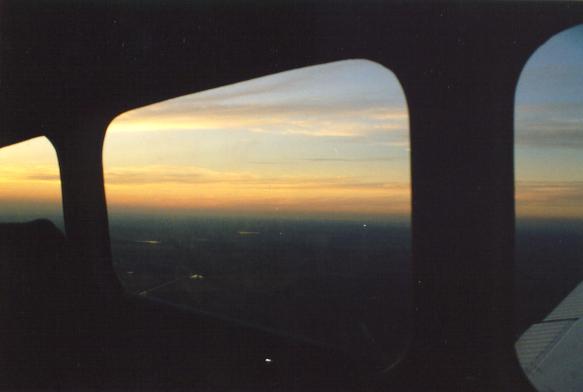
I enjoy flying the Musketeer. Although it's not a great deal faster than the 172 (about 10 knots), it does have a bit more of a big airplane feel. The view in the pattern from a low wing when coming home is also refreshing (and it makes the pattern at an unfarmiliar airport, such as the trip to Victoria, much easier). I've had people come up to me and say "Wow, a Musketeer" because you don't see that many of them around. I bumped into someone at Victoria who had restored one, and was saying how he enjoyed it when he had it. "Pity it doesn't have a 200 hp engine" he said, so he was impressed when I told him that this was a 200 hp model!
Now if some ATC guy can tell me why I'm always mistaken for a Baron when I call in and tell them I'm a Beech 23...